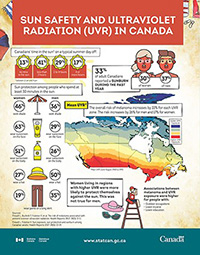The Business & Community Newsletter – July 2017
Archived Content
Information identified as archived is provided for reference, research or recordkeeping purposes. It is not subject to the Government of Canada Web Standards and has not been altered or updated since it was archived. Please "contact us" to request a format other than those available.

Summer is here and most Canadians are eager to spend time outdoors to take full advantage of everything the season has to offer.
What does it mean for our health? In this month's newsletter, we are letting the sunlight shine on health issues.
Feature articles

Nutrition
Low carb diet, low/high fat diet, high fiber, calorie counting, high protein—what we eat and how much is top of mind in blogs and news these days. But just what are Canadians eating? The recently released article Nutrition: Nutrient intakes from food and nutritional supplements, using data from the 2015 Canadian Community Health Survey on nutrition, gets to the heart of the matter.
Health behaviours
The Canadian Community Health Survey (CCHS) is also the source of information on the various health behaviours of Canadians. The article Healthy Behaviours, 2015 combines four indicators into a single score, called the Healthy Behaviours Score (HBS). The HBS is based on these four indicators: smoking, drinking, physical activity, and fruit and vegetable consumption. What is your score?
What's new under the sun?
 Ultraviolet radiation (UVR) is part of the total radiation that reaches the surface of the Earth. UVR exposure has harmful effects on the skin, including sunburn, skin aging, and skin cancer.
Ultraviolet radiation (UVR) is part of the total radiation that reaches the surface of the Earth. UVR exposure has harmful effects on the skin, including sunburn, skin aging, and skin cancer.
Statistics Canada Health Reports features two new studies. The first one describes the risk of melanoma associated with ambient summer ultraviolet radiation and the second, titled Sun exposure, sun protection and sunburn among Canadian adults, examine associations between demographic and socioeconomic characteristics, sun protection behaviour, and sunburn, and the influence of ambient summer erythemal UVR on these outcomes.
Take a look at this infographic for a quick overview of these two studies.
Health Indicators
Over 80 indicators measure the health of the Canadian population and the effectiveness of the health care system. Designed to provide comparable information at the health region and provincial/territorial levels, these data are produced from a wide range of the most recently available sources.
To access these data, visit our Health Indicators web page.
Quiz
Test your research skills and knowledge on the latest health statistics by taking this quiz! You'll find the answers at the end of the newsletter.
1. According to the 2017 Health Reports, _____ of respondents reported having a sunburn in the past 12 months.
- One-tenth
- One-fifth
- One-third
2. The risk of skin cancer is higher for those living in regions of higher summer UVR exposure. For example, residents of Toronto had a _____ higher risk than residents of Montréal.
- 5%
- 12%
- 16%
3. Canadians still get most of their daily energy intake from carbohydrates. True or False?
4. Nearly _____ of Canadians took at least one multivitamin supplement in 2015.
- one quarter
- one half
- one fifth
- three quarters
5. The Healthy Behaviours Score (HBS) counts the number of positive health behaviours an individual has. Which of the following are used to determine an individual's HBS?
- Physical activity and fruit and vegetable consumption
- Smoking status
- Drinking status
- All of the above
Also worth reading
Cycling in Canada
 The health benefits of physical activity are widely recognized. In an era when nearly a third of children and youth and just under two-thirds of adults are overweight or obese, cycling for leisure or transport is a valuable form of exercise. Cycling is also good for the environment, commuting by bicycle helps to alleviate road congestion and noise pollution and reduces emissions.
The health benefits of physical activity are widely recognized. In an era when nearly a third of children and youth and just under two-thirds of adults are overweight or obese, cycling for leisure or transport is a valuable form of exercise. Cycling is also good for the environment, commuting by bicycle helps to alleviate road congestion and noise pollution and reduces emissions.
In 2013/2014, an estimated 12 million Canadians (41%) aged 12 or older reported that they had cycled in the previous year. Helmet users were more likely than non-users to engage in what are generally considered precautionary behaviours.
Cycling in Canada provides an overview of cycling, based on data from the 1994/1995 National Population Health Survey, the 2013/2014 Canadian Community Health Survey and the Vital Statistics–Death Database.
Other releases in Statistics Canada's publication, Health Reports:
Answers to the quiz:
1. C
2. C
3. True
4. A
5. D
- Date modified:

